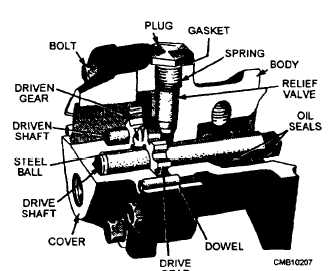4. Fuel pump (supply pump, not an injection pump).
5. Fuel strainer or primary filter.
6. Fuel filter (secondary).
7. Fuel lines.
8. One-way check valve.
9. Restricted fitting on in-line engines or a restricted TEE on V-type engines.
Fuel Pump
The fuel pump is a positive displacement gear-type unit that transfers fuel from the tank to the injectors at 65 to 75 psi (fig. 5-24). The standard pump has the ability to deliver 1.5 gallons per minute, or 90 gallons per hour.
The fuel pump body and cover are aligned by means of two dowels. The body and cover are machined surfaces that contain no gasket between them, although a thin coat of sealant applied to these surfaces is recommended at installation. A relief valve bypasses fuel back to the inlet side of the pump when pressure reaches above the 65 to 75 psi.
There are two oil seals pressed into the pump bore from the flanged end for the following purposes:
1. The seal closest to the drive coupling prevents lube oil from entering the fuel pump.
2. The inner seal closest to the pump gears prevents fuel leakage.
The installed seals do not butt up against each other, but have a small space between them. Drilled and taped

Figure 5-24. - Typical gear fuel pump assembly.
into this cavity in the fuel pump body are two small holes - one which is usually plugged and the other one is open to allow any fuel or lube oil to drain, thereby indicating damaged seals. Sometimes a small fitting and tube extend from one of these holes to direct any leakage to a noticeable spot. Acceptable leakage should not exceed 1 drop per minute.
If you are ever in doubt as to the rotation of the fuel pump, it can be identified as follows:
1. Stamped on the pump cover are the letters LH or RH, plus an arrow indicating the direction of rotation.
2. On in-line engines, the rotation of the fuel pump can be determined by its location on the engine. When viewed from the flywheel end: left-hand side location, LH pump rotation; right-hand side location, RH pump rotation.
3. A similar method would be to grasp the pump in your left or right hand, as it mounts on the engine. Whichever thumb covers the relief valves indicates the rotation of the pump.
The letter I/L (inlet) is also stamped on the pump cover; however, if not visible, the inlet side is the hole on the pump cover closest to the relief valve plug.
Since the pump constantly circulates a supply of fuel to and through the injectors, the unused fuel cools and lubricates the injectors and purges the system of any air, then returns to the fuel tank via the restricted fitting and return line.
All Detroit diesel engines are equipped with a return Line restricted fitting, the actual size varying with the engine injector size and application. Every restricted fitting has the letter R followed by a number that indicates its hole size in thousandths of an inch. Therefore, a fitting with R80 stamped on it indicates a 0.080-inch-diameter hole drilled within the fitting.
These fittings may look like an ordinary brass fittings externally; therefore, care must be taken to ensure that, in fact, the proper restricted fitting, and not just any fitting, is installed into the return line. Use of too large a fitting can lead to a low fuel pressure within the fuel manifold. This condition can cause poor engine performance. A small fitting can lead to increased fuel temperatures and some restriction against the fuel flow. Refer to the service manual of the engine for any particular specifications.
Continue Reading